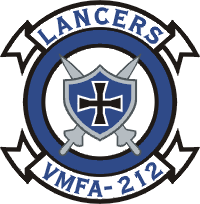
Marine Fighter Attack Squadron 212 (VMFA-212) was a United States Marine Corps F/A-18 Hornet squadron. Most recently known as the "Lancers", the squadron was last based at Marine Corps Air Station Iwakuni, Japan and fell under the command of Marine Aircraft Group 12 (MAG-12) and the 1st Marine Aircraft Wing. VMFA-212 has an extensive combat history having participated in combat operations during World War II, the Korean War, Vietnam War, the Gulf War, and Operation Enduring Freedom. Due to a re-organization within Marine aviation, the squadron was deactivated in 2008.
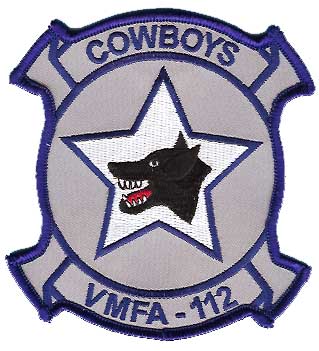
Marine Fighter Attack Squadron 112 (VMFA-112) is a reserve United States Marine Corps McDonnell-Douglas F/A-18 Hornet squadron. The squadron is based at NASJRB Fort Worth, Texas and falls under the command of Marine Aircraft Group 41 (MAG-41), 4th Marine Aircraft Wing. Their tail code is MA. During World War II the squadron saw extensive action throughout the Pacific Theater of Operations especially at the Battle of Guadalcanal as part of the Cactus Air Force. By the end of the war, its 140 air-to-air kills ranked it third among Marine Corps squadrons.
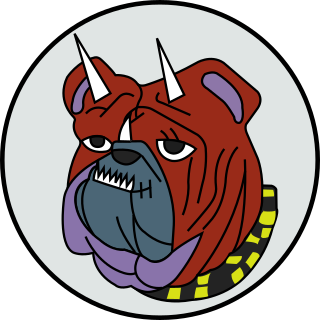
Marine Fighting Squadron 111 (VMF-111) was a reserve fighter squadron in the United States Marine Corps. Nicknamed the "Devil Dogs", the squadron was one of the first aviation squadrons in the Marine Corps and gained national attention in the 1930s as the Marine Corps show unit. The squadron fought in World War II and was later transferred to the Reserves where they fell under the command of Marine Aircraft Group 41 (MAG-41) and the 4th Marine Aircraft Wing while stationed at Naval Air Station Dallas, Texas. They were decommissioned on 22 October 1965.

Marine Fighter Attack Squadron 351 (VMFA-351) was a fighter squadron in the Marine Forces Reserve. The squadron was based at Naval Air Station Atlanta and participated in action during World War II and was decommissioned in 1975.
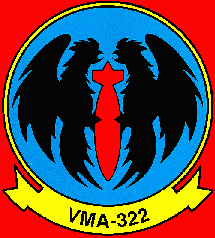
Marine Attack Squadron 322 (VMA-322) was an attack squadron in the United States Marine Corps. The squadron, also known as the "Fighting Gamecocks", fought in World War II and later became a part of the Marine Forces Reserve based out of Naval Air Station South Weymouth, Massachusetts.
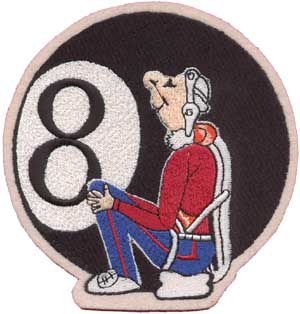
Marine Fighter Squadron 123 (VMF-123) was a fighter squadron of the United States Marine Corps during World War II and later in the Marine Forces Reserve. Known as the "Flying Eight Balls," the squadron fought at Guadalcanal, Iwo Jima, and Okinawa and served as a training squadron for replacement pilots during the Korean War. The squadron was decommissioned on 31 October 1965 at Naval Air Station Los Alamitos.
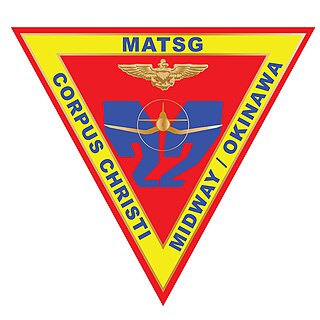
Marine Aviation Training Support Group 22 (MATSG-22) is a United States Marine Corps aviation training group that was originally established during World War II as Marine Aircraft Group 22 (MAG-22). Squadrons from MAG-22, were decimated at the Battle of Midway and, after reconstituting, fought during the Battle of Okinawa. The group was deactivated following the end of the war and was not reactivated until 1 May 2000, when the Marine Aviation Detachment at Naval Air Station Corpus Christi, Texas was renamed MATSG-22.
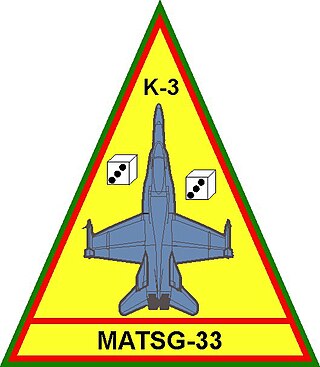
Marine Aviation and Training Support Group 33 (MATSG-33) is a United States Marine Corps aviation training group that was originally established during World War II as Marine Aircraft Group 33 (MAG-33). Fighter squadrons from MAG-33 fought most notably during the Battle of Okinawa and also as the first Marine aviation units to support the Korean War when they arrived as part of the 1st Provisional Marine Brigade. They helped stabilize the United Nations positions during the Battle of Pusan Perimeter and fought in Korea for the remainder of the war. At some point in the 1960s, the group was deactivated and was not reactivated until 2000, when Marine Aviation Training Support Group at Naval Air Station Oceana, Virginia was renamed MATSG-33.
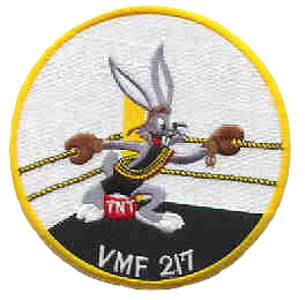
Marine Attack Squadron 217 (VMA-217) was a fighter squadron of the United States Marine Corps that was activated and fought during World War II. Known as "Max’s Wild Hares", they fought in many areas of the Pacific War including the Battle of Iwo Jima. Following the surrender of Japan, the squadron was deactivated on 10 March 1946. They were briefly reactivated as part of the Reserves but were again deactivated in 1964 and remain in an inactive status today.

Marine Fighting Squadron 215 (VMF-215) was a fighter squadron of the United States Marine Corps that was commissioned and fought during World War II. Known as "The Fighting Corsairs", the squadron fought in many areas of the Pacific War, including the Battle of Bougainville. During its four-and-a-half month tour, the squadron was credited with shooting down 137 enemy aircraft, fourth most in Marine Corps aviation history.

Marine Fighting Squadron 222 (VMF-222) was a fighter squadron of the United States Marine Corps that was activated and fought during World War II. Known as "The Flying Deuces," they fell under the command of Marine Aircraft Group 14 (MAG-14) and fought in many areas of the Pacific War, including the Philippines campaign (1944–45) and the Battle of Okinawa. During the war, the squadron was credited with shooting down 53 enemy aircraft and was the sister squadron to VMF-215. They were deactivated on 31 December 1949.
Marine Fighting Squadron 413 (VMF-413) was a fighter squadron of the Marine Forces Reserve during the Cold War. It descended from bombing squadron VMB-413, which was the Marine Corps' first medium bomber squadron and had fought during World War II. Best known as "Night Hecklers" and the "Shamrocks", the squadron fought in many areas of the Pacific War.

Marine Fighting Squadron 511 (VMF-511) was a fighter squadron of the Marine Corps and Marine Forces Reserve during World War II and the Cold War which flew aircraft types such as the F6F Hellcat, F4U Corsair, and the F-8 Crusader. They were originally activated during World War II and fought during the Battle of Okinawa and the Battle of Balikpapan (1945). They specialized in close air support and during the course of the war were credited with only one plane shot down.
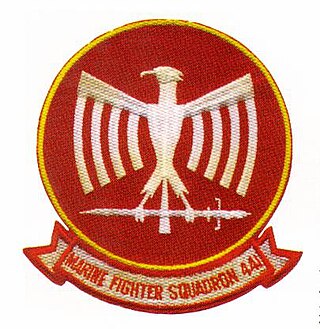
Marine Fighting Squadron 441 (VMF-441) was a fighter squadron of the Marine Forces Reserve during the Cold War. Originally commissioned during World War II, the squadron fought during the Battle of Okinawa. Nicknamed "The Blackjacks", VMF-441 was credited with 49 planes shot during the course of the war. Following the surrender of Japan, the squadron was decommissioned on 11 July 1946. They were reactivated in the Marine Air Reserve and were based out of Naval Air Station Niagara Falls, New York.
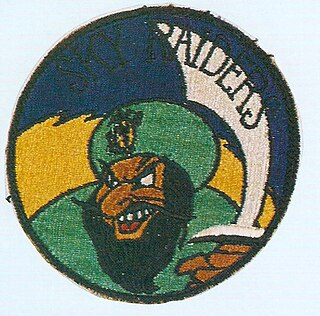
Marine Fighting Squadron 452 (VMF-452) was a fighter squadron of the United States Marine Corps that was commissioned and fought during World War II. Known as the "Sky Raiders", they flew the F4U Corsair, and the Grumman TBF Avenger, fell under the command of Marine Carrier Group 5 (MCVG-5) and fought in the Battle of Okinawa. The squadron is best known for being aboard the USS Franklin (CV-13) when she was severely damaged by Japanese kamikaze planes of the coast of Okinawa on 19 March 1945. VMF-452 was deactivated on 31 December 1949 and has remained in an inactive status since.
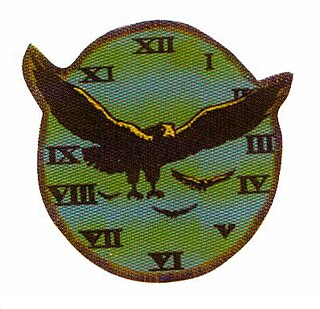
Marine Attack Squadron 543 (VMA-543) was an aviation unit of the United States Marine Corps. The squadron, also known as the "Night Hawks", were part of the Marine Forces Reserve and were based at Naval Air Station Glenview, Illinois until their deactivation on 1 April 1974. Originally activated during World War II, they fought in the Battle of Okinawa as part of the Tactical Air Force. The squadron was credited with downing 15 Japanese aircraft during the war. Following the surrender of Japan, the squadron was deactivated only to be later reactivated as part of the Reserves. They were again deactivated in 1974 and remain in an inactive status today.

Marine Fighter Attack Squadron 124 (VMFA-124) was a flying squadron in the Marine Forces Reserve based out of Naval Air Station Memphis flying the Douglas A-4 Skyhawk. They were part of Marine Aircraft Group 42 and were decommissioned on 19 June 1999.
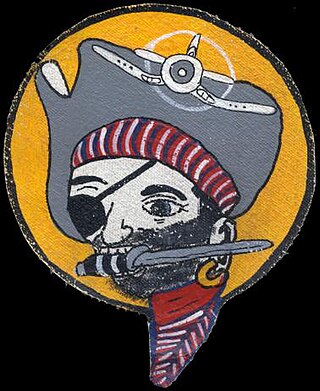
Marine Fighting Squadron 512 (VMF-512) was a fighter squadron of the United States Marine Corps during World War II. The squadron was aircraft carrier based during the last year of the war and supported combat operations during the Battle of Okinawa and the Battle of Balikpapan (1945). Following the end of World War II they were deactivated on 10 March 1946 and remain in an inactive status today.

Marine Fighting Squadron 213 (VMF-213) was a reserve fighter squadron in the United States Marine Corps. Nicknamed the "Hell Hawks", the squadron fought during World War II in the Philippines and at the battles of Iwo Jima and Okinawa. With its assignment to the USS Essex (CV-9) and Air Group 4, VMF-213 along with VMF-124 was one of the first two Marine squadrons to augment carrier air groups during World War II. The squadron was credited with downing 117 enemy aircraft during the war.

Marine Fighter Squadron 541 (VMF-541) was a reserve fighter squadron of the United States Marine Corps. Originally commissioned during World War II as a night fighter unit flying the F6F-5N Hellcat, the squadron participated in combat action over Peleliu and while supporting the liberation of the Philippines in 1944–45. During the war, VMF(N)-541 was credited with downing 23 Japanese aircraft. Following the war, the squadron participated in the occupation of Northern China until returning to the States to be decommissioned on 20 April 1946. The squadron was reactivated sometime after the war in the Marine Corps Reserve until being decommissioned again in the early 1960s.





























